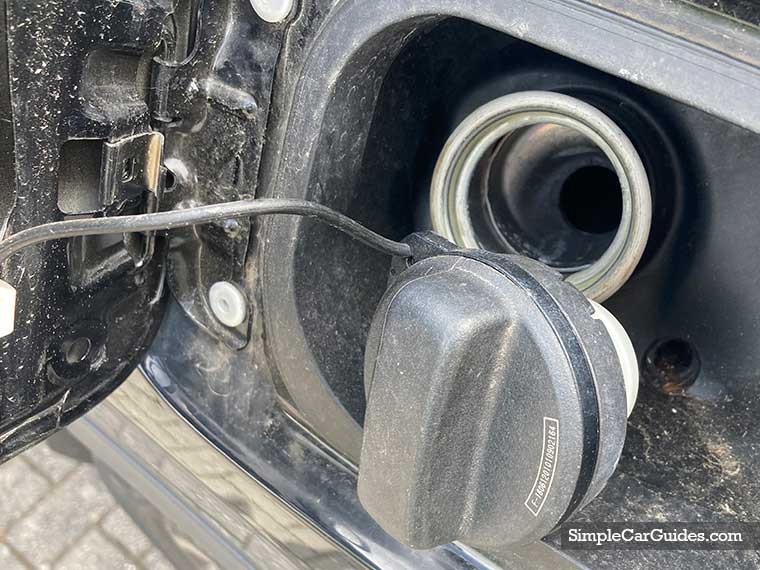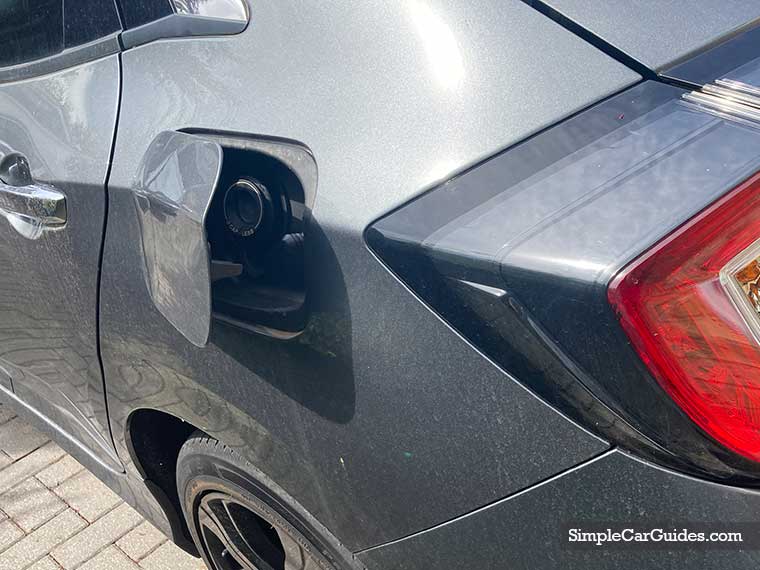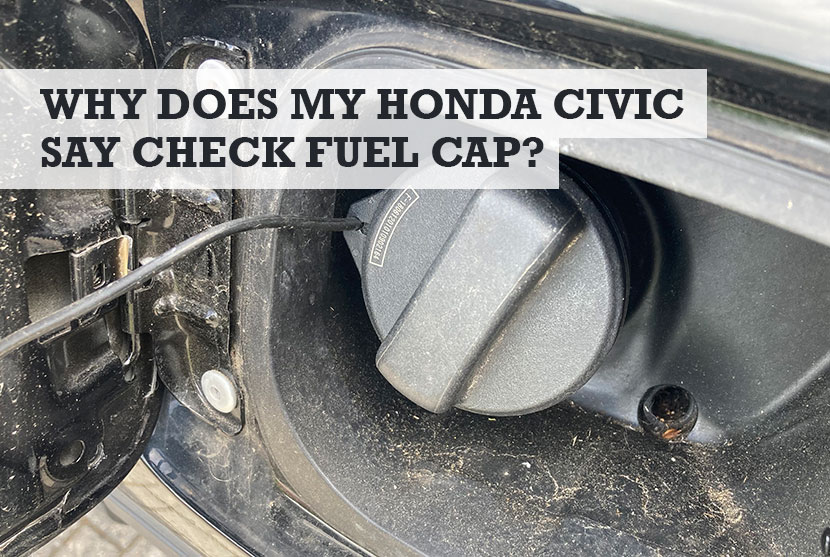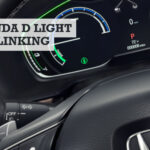As many Honda Civic owners will attest, the car will occasionally display warning messages on the dashboard, many of which will lead to great anxiety… and sometimes unnecessarily so! One of the more frequent is the “check fuel cap” warning message light.
But what does it mean when you Civic tells you to check the fuel cap, and should you be worried and still be driving? Here’s all you need to know.
Why does my Honda Civic say check fuel cap? Check fuel cap means there is a problem with your gas cap or the sensor that monitors it. While this may seem like a minor issue, it could mean it’s loose, fuel is leaking, or an problem with the gas cap sensor’s electronics.
Here’s what it means when your Honda Civic says check fuel cap.
Causes of the Honda Civic “check fuel cap” message
1. A loose or damaged gas cap
One of the most common reasons why the Honda Civic says to check the fuel cap is because the gas cap is not properly tightened, or even damaged. A damaged gas cap may cause fuel to leak from your car, which can be both dangerous and costly.
A leaky gas cap can also lead to engine misfires and an illuminated check engine light. Even if your gas cap seems tight, it may be damaged and need to be replaced.

2. Inspect the fuel tank cap
If the gas cap is not the problem, the next is to inspect the fuel tank cap. The fuel tank cap is located on the side of the fuel tank and seals it to prevent fuel from leaking out. Over time, the fuel tank cap can become damaged and need to be replaced.
If you notice any cracks or damage to the fuel tank cap, it should be replaced as soon as possible.
3. A faulty sensor
In some cases, the Honda Civic check fuel cap message might not be with the gas cap or fuel tank cap at all. The sensor that monitors your gas cap is located under the hood of your car. This sensor can become faulty over time, causing the Honda Civic to say check fuel cap.
If this sensor is not working properly, it will not be able to correctly detect when the gas cap is open or closed.
As a result, your car will not be able to properly regulate fuel intake and may lose fuel efficiency.
4. A damaged or dislodged EVAP canister
Your Civic’s fuel tank is connected to the Evaporative Emissions Control (EVAP) System. The EVAP canister is responsible for storing vapors from the fuel tank. These vapors are then routed to the engine so they can be burned off.
If the EVAP canister is damaged or dislodged, it can cause fuel vapors to leak into the atmosphere.
Additionally, this will trigger the Honda Civic to say check the fuel cap because the sensor will not be able to accurately detect when the gas cap is closed.
5. A clogged vent line
The vent line is responsible for allowing air to flow into the gas tank as fuel is used. If this line becomes clogged, it can cause a build-up of pressure in the gas tank. This pressure can eventually cause the gas cap to pop off, resulting in a dangerous fuel leak.
Additionally, a clogged vent line will mean your Honda Civic says to check the fuel cap.
6. Faulty software or wiring
In some cases, faulty software or wiring can cause the sensor that monitors your gas cap to malfunction. If this happens, it will not be able to accurately detect when the gas cap is open or closed, which will result in the Honda Civic asking you to check the fuel cap as a warning message.
How to prevent the check fuel cap message appearing
If your Honda Civic says tighten fuel cap or check fuel cap, I recommend you pull over when you can safely and check it.

Ignoring the “check fuel cap” message can lead to more serious problems down the road, including reduced engine performance and even possible engine damage. So if you are seeing this message on your dashboard, take it seriously and work.
By following these simple tips, you can help keep your Honda Civic running smoothly and prevent the check fuel cap message from appearing again in the future.
- The most important thing is to make sure that you regularly maintain your car, including checking for any loose or damaged parts, such as the gas cap and fuel tank cap.
- Additionally, you should inspect your onboard diagnostic (OBD) system, EVAP canister, charcoal canister, and vent line on a regular basis to identify any potential problems before they become serious issues.
- It is also important to have your car’s software and wiring inspected on a regular basis by a qualified mechanic to avoid any software or wiring-related issues with the sensor that monitors the gas cap.
- Another thing to keep in mind is that if you frequently drive in dusty or muddy conditions, your fuel cap can become clogged with debris. This can also cause the check fuel cap message to appear, so be sure to clean your fuel cap regularly and check for dirt or debris if this is a frequent concern for you.
- It is a good idea to schedule regular maintenance for your Honda Civic. Some experts recommend getting your car checked every few months or so, especially if you drive in areas with extreme climates or frequent stop-and-go traffic. This can help catch minor issues before they have a chance to become more serious.
Related questions
Can I drive my Honda if it says check fuel cap?
You can drive a Honda if it says to check your fuel cap, but only in certain circumstances. In simple terms, it all depends on the specific issue that is causing your “check fuel cap” light to come on.
In some cases, driving with a faulty gas cap can lead to serious problems or engine damage over time.
However, if your car’s sensor is simply detecting an open gas cap or loose gas cap seal and there are no other issues present, then it should be safe for you to drive at least a very short distance until you can pull over to fix it or get a mechanic to inspect the problem.
Why is my Honda Civic telling me to tighten my fuel cap?
Your Civic is asking you to tighten your fuel cap as it’s either loose or missing. Here’s what the Honda manual states:
“If the fuel fill cap is missing or not tightened properly, you will see ‘‘TIGHTEN FUEL CAP.’’ Make sure the fuel cap is installed and tightened at least one click.”
How do I know if my fuel cap is bad?
There are a few different ways to tell if your Honda’s fuel cap is bad. Primarily, you should look for signs of damage or corrosion on the gas cap itself. Also check for any unusual smells around your fuel / gas cap area or in the car itself, as this could be an early sign of a leak.
Another potential sign that it’s time to replace your gas cap is if your Honda Civic starts displaying the “check fuel cap” message repeatedly.
If you see this message repeatedly, it’s best to have your car checked out by a mechanic as soon as possible to avoid further problems.
How to reset check fuel cap Honda Civic?
If you’re getting the “Check Fuel Cap” message on your Honda Civic, it means that the vehicle’s computer has detected that the fuel cap is not tight. You can reset the fuel cap warning by first turning the ignition key to the ON position (do not start the engine).
Then, tighten or replace the fuel cap and wait for a few seconds. The light should go off. If it doesn’t, drive for a few minutes and then recheck to see if the light has gone out.
If the light still won’t turn off, you may need to take your car in to a mechanic to have it diagnosed. If it doesn’t reset it could be caused by several issues with your vehicle’s fuel system, including leaks or problems with the fuel pump.
Depending on the age and condition of your Honda Civic, a check engine light might also come on after you replace the gas cap. Once again, drive your car for several minutes until the light has gone out.
You may also need to reset the computer for this to happen. To do so, disconnect the battery for about 10-15 minutes and then reconnect it when you’re ready to start driving again.
How often should I replace my gas cap?
You typically won’t need to replace your gas cap very often, but it is a good idea to inspect it regularly for any signs of damage or wear and tear.
Further, you should clean your gas cap periodically to remove any dirt or debris. If you drive in dusty or muddy conditions, it’s also a good idea to check the cap for clogs more often, as this can be a common cause of the “check fuel cap” message.
Finally, you should have your car inspected on a regular basis by a qualified mechanic to avoid any issues with the sensor that monitors the gas cap.
Conclusion
The Honda Civic is a popular compact car that is known for its reliability and excellent performance. It also comes with a range of warnings to tell you when a problem has occurred.
Understanding those warnings will help you drive safer… you can find out more about other common warnings below.






